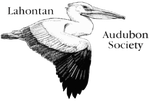|
By Tina Nappe Beginning in 1986, a drought in the Sierra Nevada mountains resulted in reducing the amount of water the Truckee and Carson Rivers received and normally distributed to Lahontan Valley farmers and terminus wetlands. TCID - the Truckee Carson Irrigation District managing agency allocated water to farms based on their water rights. After farms received their allocation, excess water would normally flow into a terminus commonly called Carson Lake and Pasture (CLP). The farmers collectively grazed their cattle in the irrigated pasture, but little or no excess water was available to greet the arrival of thousands of shorebirds. The CLP had no water rights. In fact CLP had no legal existence to defend. Water levels began to drop, increasing toxicity levels and leading to deformity and death for fish and birds. Nearby Stillwater National Wildlife Refuge, designated in 1949, also had no water rights. Thousands of ducks and geese relied on Stillwater. These two terminus wetlands, the last of ice-age Lake Lahontan were all that was left of what was once 100,000 acres of wetlands historically fed by the Humboldt and Carson Rivers. To increase available farm land in Lahontan Valley, Derby Dam was built in 1903 diverting water from the Truckee River to Lahontan Valley. The result was Pyramid Lake water levels dropped threatening the future of Anaho Island, a large white pelican rookery and two native fish species the Lahontan cutthroat trout and cui ui. Then in 1985, the Hemispheric Shorebird Reserve Network (HSRN) was created, designating critical national shorebird migration sites. William Molini, Director of Nevada Department of Wildlife, applied for recognition for CLP, reporting that 250,000 shorebirds birds in a good year were using the site. In May 1988, the U.S. Fish and Wildlife Service celebrated the recognition of CLP with a dedication ceremony on site. Now CLP had standing. But what about water for Stillwater and Carson Lake? Two new organizations emerged. The Nevada Waterfowl Association (NWA) a duck hunters organization, founded in 1987 to save Lahontan Valley wetlands held its first fundraiser. The goal was to purchase water rights to have “standing” in water negotiations. The Lahontan Valley Wetlands Coalition (LVWC), comprised of sportsmen, conservation organizations, the Nevada Department of Wildlife, U.S. Fish and Wildlife joined forces to make a plan. The Lahontan Audubon Society, ably represented by Jane Sunday and Connie Douglas, was one of the organizations. The group began meeting every two weeks to gather information and to “get on the same page” i.e. to speak with one voice for the wetlands. On a parallel course, Senator Harry Reid had stated his goal was to settle the water wars on the Truckee River between the cities, the Tribe, and TCID. LVWC seized an opportunity to participate and gain recognition for Lahontan Valley wetlands and funding to support them. The final legislation S. 1554 passed in the 11th hour in 1989 with the assistance of congresswoman Vucanovich. The legislation acknowledged CLP existence and ultimate transfer to NDOW, set aside 800 acres of wetlands for the Fallon Paiute-Shoshone Tribe, and authorized funding for all three wetland locations totaling 24,000 acres, far less than the 100,000 acres which once covered the valley but at least providing some security for the future. CLP transferred to NDOW in 2023. Note: S. 1554/PL 101-618 were widely covered in the press. There were also local articles on botulism in Lahontan Valley. References: LAS Articles on Lahontan Valley - November 1983, January-February, 1988, May-June 1988, March-April 1990, January-February 1989. |
topics
All
Archives
July 2024
|



 RSS Feed
RSS Feed